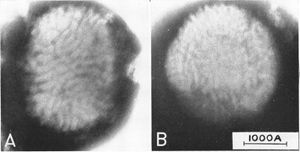Myxoma Virus: Difference between revisions
Darcypaulus (talk | contribs) No edit summary |
Darcypaulus (talk | contribs) |
||
| Line 6: | Line 6: | ||
==Characteristics of the host== | ==Characteristics of the host== | ||
[[File:europeanrabbit.jpg|thumb|The european rabbit (''Oryctolagus cuniculus'') is the host of the Myxoma virus (1)]] | [[File:europeanrabbit.jpg|thumb|The european rabbit (''Oryctolagus cuniculus'') is the host of the Myxoma virus (1)]] | ||
The host of the myxoma virus is European rabbits (''Oryctolagus cuniculus''). In this specific host, the myxoma virus causes a deadly infection | The host of the myxoma virus is European rabbits (''Oryctolagus cuniculus''). In this specific host, the myxoma virus causes a deadly infection called myxomatosis. The myxoma virus can infect other types of rabbits (including the American rabbit, ''Oryctolagus cuniculus''), but only causes myxomatosis in European rabbits. The virus causes a tumor at the infection sight of the rabbits and causes swelling of the adjacent connective tissues. Secondary myxoma tumors are found on other areas of infected rabbits (2). | ||
==Host-Symbiont Interaction == | ==Host-Symbiont Interaction == | ||
Revision as of 21:08, 1 December 2011
Characteristics of the symbiont/pathogen
The myxoma virus an 161.8-kb long enveloped virus. The myxoma virus is a member of the poxvirus family and is of the Leporipoxvirus genus (4).
Characteristics of the host
The host of the myxoma virus is European rabbits (Oryctolagus cuniculus). In this specific host, the myxoma virus causes a deadly infection called myxomatosis. The myxoma virus can infect other types of rabbits (including the American rabbit, Oryctolagus cuniculus), but only causes myxomatosis in European rabbits. The virus causes a tumor at the infection sight of the rabbits and causes swelling of the adjacent connective tissues. Secondary myxoma tumors are found on other areas of infected rabbits (2).
Host-Symbiont Interaction
What kind of interaction do host and symbiont have? How is the host affected by the relationship? How does the host acquire and transmit the symbiont? Is the interaction obligate or facultative?
Molecular Insights into the Symbiosis
The myxoma virus has a M-T7 protein that is specific in that it specifically binds rabbit IFN-gamma. By doing this, the M-T7 protein inhibits a regulatory cytokine that controls the host’s immune response to viral infections. Additionally, M11L genes prevent virus-induced apoptosis in infected rabbit T lymphocytes. This extends the host range by inhibiting the apoptosis in the T lymphocytes that are infected (3).
Ecological and Evolutionary Aspects
What is the evolutionary history of the interaction? Do particular environmental factors play a role in regulating the symbiosis?
The myxoma virus origionated in North and South America as it evolved in close association with sylvilagus. However, after 1950, the disease began to be used as a way to control rabbit populations in Europe, Australia, and Chili. Many different strands of the myxoma virus exist with virulances ranging from 50-95%. The more virulent strands were used as a way to control rabbit populations in these countries between 1950 and 1960 (5).
Recent Discoveries
Describe two findings on the symbiosis published within the last two years.
References
1.) http://www.cdc.gov/eid/article/17/4/pdfs/10-1146.pdf Camus-Bouclainville, C., Gretillat, M., Py, R., Gelfi, J., Guérin, J., and Bertagnoli, S. "Genome Sequence of SG33 Strain and Recombination between Wild-Type and Vaccine Myxoma Viruses." Emerging infectious diseases. 2011; 17(4): 633-638.
4) http://www.sciencedirect.com/science/article/pii/S0042682299900016 Cameron, C., Hota-Mitchell, S., Chen, L., Barrett, J., Cao, J., Macaulay, C., Willer, D., Evans, D., and McFaddena, D. "The Complete DNA Sequence of Myxoma Virus." Virology. 1999; 264(2): 298-318.
Edited by [Darcy Paulus], students of Grace Lim-Fong
This template is just a general guideline of how to design your site. You are not restricted to this format, so feel free to make changes to the headings and subheadings and to add or remove sections as appropriate.


